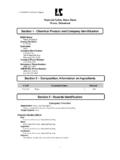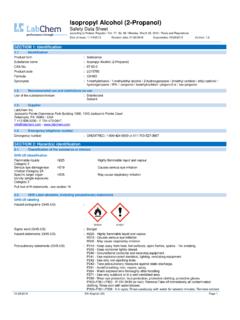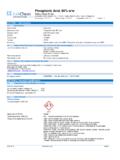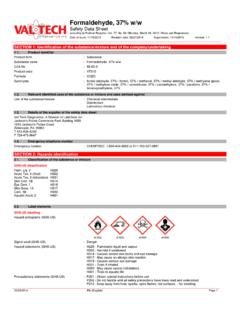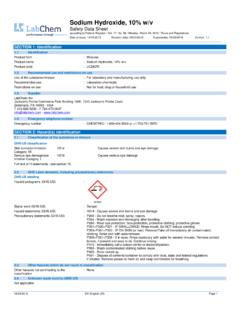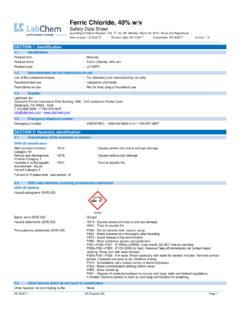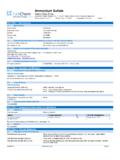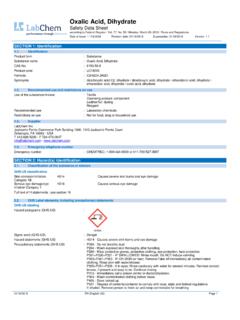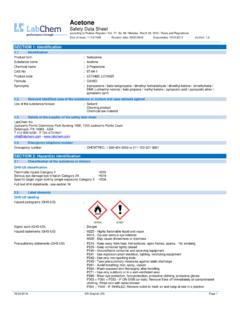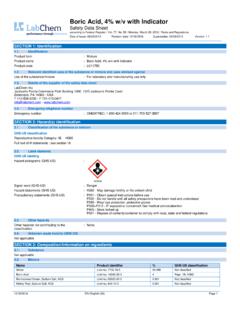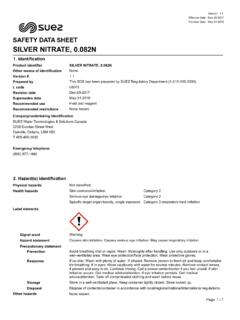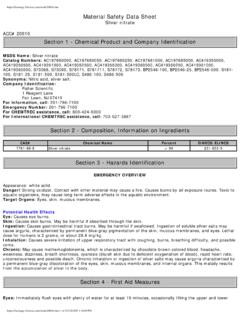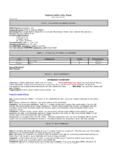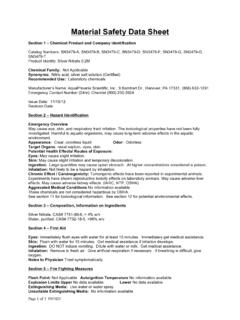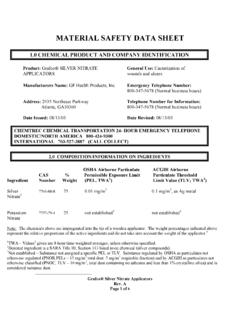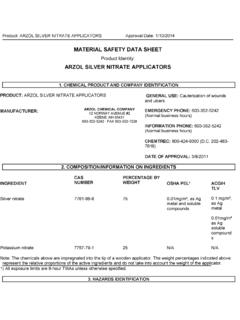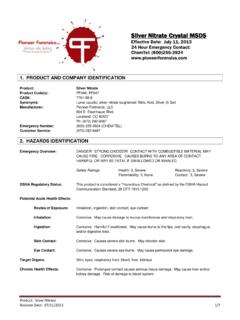Transcription of Silver Nitrate - LabChem Inc
1 Silver Nitrate Safety Data Sheet according to Federal Register / Vol. 77, No. 58 / Monday, March 26, 2012 / Rules and Regulations Date of issue: 11/21/1998 Revision date: 06/04/2013 Supersedes: 08/15/2008 Version: 06/26/2013 EN (English) Page 1 SECTION 1: Identification of the substance/mixture and of the company/undertaking Product identifier Product form : Substance Substance name : Silver Nitrate CAS No : 7761-88-8 Product code : LC22500 Formula : AgNO3 Synonyms.
2 Lunar caustic / Nitrate of Silver / nitric acid Silver salt / nitric acid Silver (1+) salt / Silver mononitrate / Silver Nitrate / Silver (I) Nitrate / Silver (I) salt nitric acid BIG no : 10282 Relevant identified uses of the substance or mixture and uses advised against Use of the substance/mixture : Laboratory chemical Chemical intermediate Water treatment Oxidant Photographic chemical: component Cosmetic product: dyestuff Details of the supplier of the safety data sheet LabChem Inc Jackson's Pointe Commerce Park Building 1000, 1010 Jackson's Pointe Court 16063 Zelienople, PA - USA T 412-826-5230 - F 724-473-0647 - Emergency telephone number Emergency number : CHEMTREC: 1-800-424-9300 or 011-703-527-3887 SECTION 2: Hazards identification Classification of the substance or mixture GHS-US classification Ox.
3 Sol. 2 H272 Acute Tox. 4 (Oral) H302 Skin Corr. 1B H314 Eye Dam. 1 H318 Aquatic Acute 1 H400 Aquatic Chronic 1 H410 Label elements GHS-US labelling Hazard pictograms (GHS-US) : GHS03 GHS05 GHS07 GHS09 Signal word (GHS-US) : Danger Hazard statements (GHS-US) : H272 - May intensify fire; oxidiser H302 - Harmful if swallowed H314 - Causes severe skin burns and eye damage H318 - Causes serious eye damage H400 - Very toxic to aquatic life H410 - Very toxic to aquatic life with long lasting effects Precautionary statements (GHS-US) : P210 - Keep away from heat, open flames, sparks. - No smoking P220 - Keep/Store away from combustible materials P221 - Take any precaution to avoid mixing with combustibles P260 - Do not breathe dust P264 - Wash exposed skin thoroughly after handling P270 - Do no eat, drink or smoke when using this product P273 - Avoid release to the environment P280 - Wear eye protection, face protection, protective gloves, protective clothing P301+P312 - IF SWALLOWED: call a POISON CENTER or doctor/physician if you feel unwell P301+P330+P331 - IF SWALLOWED: Rinse mouth.
4 Do NOT induce vomiting P303+P361+P353 - IF ON SKIN (or hair): Remove/Take off immediately all contaminated Silver Nitrate Safety Data Sheet according to Federal Register / Vol. 77, No. 58 / Monday, March 26, 2012 / Rules and Regulations 06/26/2013 EN (English) 2/9 clothing. Rinse skin with water/shower P304+P340 - IF INHALED: Remove person to fresh air and keep comfortable for breathing P305+P351+P338 - If in eyes: Rinse cautiously with water for several minutes. Remove contact lenses, if present and easy to do. Continue rinsing P310 - Immediately call a POISON CENTER/doctor/.. P321 - Specific treatment (see Personal precautions on this label) P330 - If swallowed, rinse mouth P363 - Wash contaminated clothing before reuse P370+P378 - In case of fire: Use carbon dioxide (CO2), powder, alcohol-resistant foam for extinction P391 - Collect spillage P405 - Store locked up P501 - Dispose of contents/container to comply with local, state and federal regulations Other hazards Other hazards not contributing to the classification : None.
5 Unknown acute toxicity (GHS US) No data available SECTION 3: Composition/information on ingredients Substances Substance type : Mono-constituent Name Product identifier % GHS-US classification Silver Nitrate (Main constituent) (CAS No) 7761-88-8 100 Ox. Sol. 2, H272 Acute Tox. 4 (Oral), H302 Skin Corr. 1B, H314 Eye Dam. 1, H318 Aquatic Acute 1, H400 Aquatic Chronic 1, H410 Full text of H-phrases: see section 16 Mixture Not applicable SECTION 4: First aid measures Description of first aid measures First-aid measures general : Check the vital functions. Unconscious: maintain adequate airway and respiration. Respiratory arrest: artificial respiration or oxygen. Cardiac arrest: perform resuscitation. Victim conscious with laboured breathing: half-seated. Victim in shock: on his back with legs slightly raised. Vomiting: prevent asphyxia/aspiration pneumonia. Prevent cooling by covering the victim (no warming up).
6 Keep watching the victim. Give psychological aid. Keep the victim calm, avoid physical strain. Depending on the victim's condition: doctor/hospital. First-aid measures after inhalation : Remove the victim into fresh air. Respiratory problems: consult a doctor/medical service. First-aid measures after skin contact : Wash immediately with lots of water (15 minutes)/shower. Do not apply (chemical) neutralizing agents. Remove clothing while washing. Do not remove clothing if it sticks to the skin. Cover wounds with sterile bandage. Consult a doctor/medical service. If burned surface > 10%: take victim to hospital. First-aid measures after eye contact : Rinse immediately with plenty of water for 15 minutes. Do not apply neutralizing agents. Take victim to an ophthalmologist. First-aid measures after ingestion : Rinse mouth with water. Immediately after ingestion: give lots of water to drink.
7 Do not induce vomiting. Immediately consult a doctor/medical service. Doctor: administration of chemical antidote. Call Poison Information Centre ( ). Ingestion of large quantities: immediately to hospital. Most important symptoms and effects, both acute and delayed Symptoms/injuries after inhalation : AFTER INHALATION OF DUST: Dry/sore throat. Coughing. FOLLOWING SYMPTOMS MAY APPEAR LATER: Risk of lung oedema. Symptoms/injuries after skin contact : Caustic burns/corrosion of the skin. Symptoms/injuries after eye contact : Corrosion of the eye tissue. Permanent eye damage. Symptoms/injuries after ingestion : AFTER ABSORPTION OF HIGH QUANTITIES: Burns to the gastric/intestinal mucosa. Vomiting. Abdominal pain. Diarrhoea. Shock. Dizziness. Low arterial pressure. Disturbances of consciousness. Cramps/uncontrolled muscular contractions. Respiratory collapse. Chronic symptoms : ON CONTINUOUS/REPEATED EXPOSURE/CONTACT: May stain the skin.
8 Blue/grey discolouration of the skin. Inflammation/damage of the eye tissue. Visual disturbances. Possible inflammation of the respiratory tract. Indication of any immediate medical attention and special treatment needed Obtain medical assistance. Silver Nitrate Safety Data Sheet according to Federal Register / Vol. 77, No. 58 / Monday, March 26, 2012 / Rules and Regulations 06/26/2013 EN (English) 3/9 SECTION 5: Firefighting measures Extinguishing media Suitable extinguishing media : EXTINGUISHING MEDIA FOR SURROUNDING FIRES: All extinguishing media allowed. Unsuitable extinguishing media : No unsuitable extinguishing media known. Special hazards arising from the substance or mixture Fire hazard : DIRECT FIRE HAZARD.
9 Non combustible. INDIRECT FIRE HAZARD. Promotes combustion. Reactions involving a fire hazard: see "Reactivity Hazard". Explosion hazard : INDIRECT EXPLOSION HAZARD. Reactions with explosion hazards: see "Reactivity Hazard". Reactivity : On burning: release of toxic and corrosive gases/vapours (nitrous vapours). Decomposes on exposure to light. This reaction is accelerated on exposure to impurities. Violent to explosive reaction with many compounds : with (strong) reducers. Violent to explosive reaction with combustible materials: risk of spontaneous ignition. Advice for firefighters Precautionary measures fire : Exposure to fire/heat: keep upwind. Exposure to fire/heat: consider evacuation. Exposure to fire/heat: have neighbourhood close doors and windows. Firefighting instructions : Cool tanks/drums with water spray/remove them into safety. Cool from behind cover/unmanned monitors.
10 Dilute toxic gases with water spray. Take account of toxic fire-fighting water. Use water moderately and if possible collect or contain it. Protection during firefighting : Heat/fire exposure: compressed air/oxygen apparatus. SECTION 6: Accidental release measures Personal precautions, protective equipment and emergency procedures For non-emergency personnel Protective equipment : Gloves. Face-shield. Corrosion-proof suit. Dust cloud production: compressed air/oxygen apparatus. Emergency procedures : Mark the danger area. Prevent dust cloud formation. No naked flames. Keep containers closed. Wash contaminated clothes. In case of hazardous reactions: keep upwind. In case of reactivity hazard: consider evacuation. Measures in case of dust release : In case of dust production: keep upwind. In case of dust production: consider evacuation. Dust production: have neighbourhood close doors and windows. For emergency responders Protective equipment : Equip cleanup crew with proper protection.
